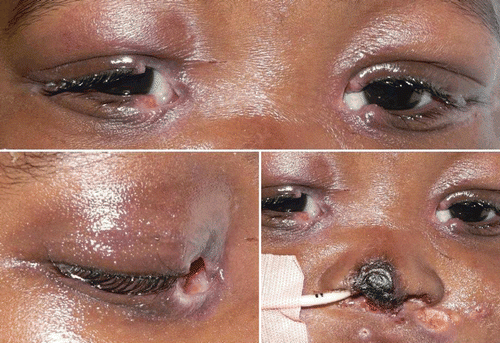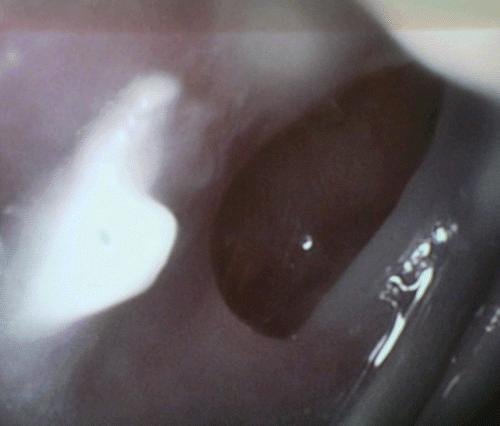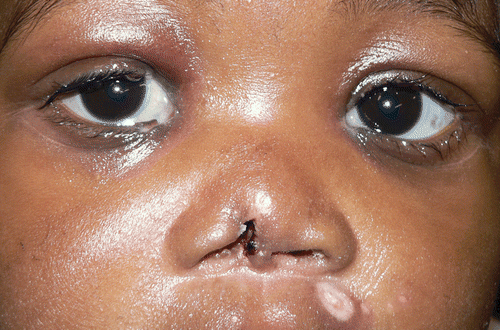TO THE EDITORS
A 16-month-old malnourished child with acquired immune deficiency syndrome (AIDS) taking highly active anti-retroviral therapy was admitted to the acute care ward with suspected septicaemia. Blood tests revealed pre-renal failure, metabolic acidosis, a decreased white cell count with neutropenia, a CD4 count of 254 × 106/litre and a HIV viral load of 54 000 RNA copies/millilitre. Blood cultures were performed and intravenous (IV) ceftriaxone antibiotic treatment was commenced empirically.
The following day he developed a pussy discharge from his eyes and ears bilaterally and a black necrotic lesion on the tip of his nose. Ocular examination revealed bilateral conjunctival injection but was otherwise unremarkable. Examination of the ears revealed bilateral inflamed tympanic membranes and a small central tympanic membrane perforation in the left ear. Swabs were taken for microscopy, culture and sensitivity testing from both eyes and ears. His eyes were treated with 6 hourly cleaning of the discharge and topical chloramphenicol ointment. His ears were treated with 2 hourly toilet and ofloxacin drops. Blood cultures and all the swabs grew pseudomonas aeruginosa sensitive to ceftazidime, tobramycin and gentamycin. His treatment was subsequently changed to IV ceftazidime and ciprofloxacin, with continuation of his eye and ear medications.
Over the next 2 days his ocular infection progressed to ulcerative lesions of both medial canthi which rapidly eroded the medial canthal ligaments and proximal lacrimal drainage apparatus symmetrically to the punctum (). The tympanic membrane perforation enlarged very quickly, as can be seen in . He was diagnosed with multifocal necrotising fasciitis involving his eyes, ears and nose. His topical eye treatment was changed to hourly cleaning and hourly ofloxacin and his ear treatment to hourly dry mopping and hourly ofloxacin. Swabs were again taken from both ears and eyes, with pseudomonas aeruginosa being cultured from all swabs with the same sensitivities as before. The cultured organism was sensitive to the antibiotics being administered IV and it was decided to observe the patient for one more day before considering surgical debridement. Fortunately the infection did not progress. After 1 week of intensive inpatient IV and topical antibiotic treatment it was evident that the infection started to resolve. (). Over the next 3 months the eyelid defect gradually decreased in size with his mother reporting occasional mild epiphora. Reconstructive surgery will be considered in the future should he develop significant symptoms or if the eyelid defect fails to heal adequately.
Necrotising fasciitis secondary to pseudomonas aeruginosa infection is uncommon. A pre-existing neutropenia may predispose to the development of necrotising fasciitis and has previously been suggested to cause pseudomonas related necrotising fasciitis to progress rapidly (Akamine et al., Citation2008). Our patient had neutropenia which was highly likely to be due to AIDS. There are only 3 other reported cases of necrotising fasciitis of the ocular adnexa, a newborn (Ganesh et al., Citation2007), a 6-week-old (Steinkolger and Huber-Spitzy, Citation1988) and a 14 day old baby (Huber-Spitzy et al., 1988). In all cases Pseudomonas aeruginosa was the causative organism, with all patients being immunocompromised (Ganesh et al., Citation2007; Huber-Spitzy et al., Citation1985; Steinkolger and Huber-Spitzy, Citation1988). Fortunately, in our case the patient responded well to intensive antibiotic treatment, as did the 14-day-old baby (Huber-Spitzy et al., Citation1985). However, the newborn and 6-week-old baby had poor outcomes, including corneal perforation (Ganesh et al., Citation2007; CitationSteinkolger and Huber-Spitzy, 1985).
Our case has several novel features including the multifocal nature of the disease and the apparent predilection of Pseudomonas for the medial canthi and proximal lacrimal apparatus, with the simultaneous rapid necrosis of the tympanic membrane and alar cartilage of the nose. This is the first report of Pseudomonas aeruginosa-related necrotising fasciitis associated with HIV/AIDS. It illustrates the aggressive nature of the disorder and the importance of early diagnosis and prompt initiation of intensive medical management.
Declaration of interest: The authors report no conflict of interest. The authors alone are responsible for the content and writing of the paper.
REFERENCES
- Akamine M, Miyagi K, Uchihara T, et al. Necrotizing fasciitis caused by Pseudomonas aeruginosa. Intern Med. 2008;47:553–556.
- Ganesh A, Al-Zuhaibi SS, Bialasiewicz AA, et al. Necrotizing Pseudomonas infection of the ocular adnexa in an infant with leukocyte adhesion defect. J Pediatr Ophthalmol Strabismus. 2007;44:199–200.
- Huber-Spitzy V, Steinkogler FJ, Grabner G. Necrotizing Pseudomonas infection of the eyelids and lacrimal ducts with orbital involvement in a newborn infant. Klin Monatsbl Augenheilkd.1985;187:287–289.
- Steinkolger FJ,Huber-Spitzy V. Necrotizing destruction of the ocular adnexa by Pseudomonas aeruginosa. J Craniomaxillofac Surg. 1988; 16:28–30.


